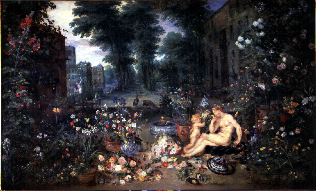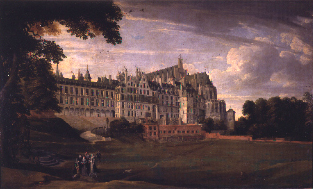


 |
The actual scent of the archducal gardens and flowers is evoked by Reynbouts’ History of Vertumnus and Pomona (Brussels, KMKG), by Brueghel’s Large Floral Bouquet (Vienna, Kunsthistorisches Museum) and by his The Archdukes in the Park of Brussels (Antwerp, Rubenshuis). |
| Then the visitor comes face to face with his Wreath of Flowers and Fruit around Our Lady (Madrid, Prado), a painting that perfectly portrays the unity of scent and sanctity. The last section is entirely dedicated to the ‘odour of sanctity’ which the Archdukes attempted to achieve by approximating to the just and Christian government described in various treatises. |
In this attempt the pietas austriaca, which was to give the rule of the Archdukes a divine touch, was of the utmost importance. Did God not punish the bad governor and reward the just prince? The prosperity of the Truce and the stress which the Archdukes and various scholars and artists placed on it, must be seen and interpreted from this point of view.
 |
The pietas austriaca is developed around four themes. The first deals with the central devotion of the Archdukes, devotion to the Blessed Virgin Mary, expressed especially in the development of Scherpenheuvel as a site of Marian pilgrimage. An anonymous Madonna carved from ‘Sichem wood’, wood from the oak in Scherpenheuvel (Edingen, Capucijnenklooster) represents the actual miraculous image. |
|
Further numerous gifts which the Archdukes donated to the shrine at Scherpenheuvel will be exhibited: an embroidered Our Lady of Scherpenheuvel (Brussels, KMKG), the Jewel casket that Isabella gave to the shrine (Scherpenheuvel, O.L.V.-basiliek), a Robe for the Miraculous Image of Scherpenheuvel (Scherpenheuvel, O.L.V.-basiliek, treasury) and the Altar cloths with matching chasubles and cowls, donated by the Archdukes on the occasion of the Twelve Years Truce (Scherpenheuvel, O.L.V.-basiliek, treasury). |
|
The internationalisation of the devotion
is expressed in the anonymous image of the Virgin of Scherpenheuvel preserved in
the Monasterio de las Descalzas Reales in Madrid. Even the court historiographer was
brought into the process, Justus Lipsius writing a Diva Sichemiensis sive Aspricollis
(Brussels, Koninklijke Bibliotheek).
Other expressions of the Marian devotion of the Archdukes — theme 2 — left traces in Justus Lipsius’ Diva Virgo Hallensis (Brussels, Koninklijke Bibliotheek), in Rubens’ Our Lady of the Rosary (Great Britain, private collection) and his Assumption of the Blessed Virgin for the church of the Discalsed Carmelite nuns in Brussels, and in the anonymous Altarcloth of Our Lady of the Rosary, painted at the request of the Archdukes for the Eglise Saints-Pierre et Paul in Chimay, and in the Altarpiece of Our Lady and the Infant Jesus surrounded by Elizabeth, John the Baptist and an angel, donated to the church of Foy-Notre-Dame.
| The particular attention which Albert and Isabella showed for their patron saints and their relics, and for devotion to the saints more generally, is reflected in the designs of Albert with his patron saint Albert of Leuven, preserved in the Philadelphia Museum of Art), in the Altar with relics from the Oratory of Isabella (Brussels, karmelietessenklooster) and in the Reliquary with a bone from the arm of Elizabeth of Hungary (Brussels, karmelietessenklooster), in the Image of St Augustine and in that of Saint Ambrose by the De Nole brothers (Lier, Sint-Gummaruskerk). Their personal devotion is expressed in the Christmas crib of the Archdukes: 11 figures and 3 sheep (Brussels, karmelietessenklooster). |
| Finally Theodore van Loon’s Conversion of St Hubert (Brussels, KMSK) and Rubens’ Grisaille Sketch for St Clare of Assisi (Oxford, Ashmolean Museum) show the range of their personal devotions. The registers of various fraternities show the dissemination of the archducal devotions among the populace. |
The final theme of the Pietas
austriaca deals with the Catholic Reformation and its shock-troops with the anonymous Painting
of the former reliquary of the Most Blessed Sacrament of Miracles in St Gudula’s
(Bruges, Kapel van het Heilig Bloed, kerkschat), and Rubens’ Francis Xavier
preaches to the Indians: sketch (Vienna, Kunsthistorisches Museum, Gemäldegalerie).
 |
 |
 |